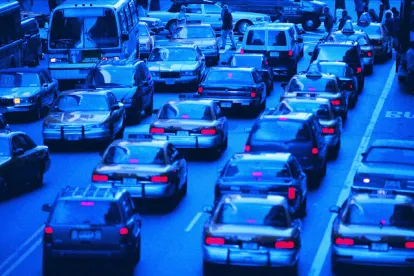You may have seen this picture circulating around the internet over the past few years. It usually comes in three to five photos, showing various forms of transit methods (car, bike, foot, train, etc.) and the space taken by those forms, including the number of people who can use each form. The intent of this photo is to make you think about how efficient we can be with our choices of transit. The thought is, if we could see how much space we take up in our cities based on if we all biked, took the streetcar, or if like most of us already do, drive our own cars, maybe we would pick a more space-efficient form of transit. The reality is, we are creatures of habit and prefer to use the most accommodating form we can identify.
At the onset of ridesharing’s launch to the masses, many thought it was a salvation for our already abundantly congested roads, but newer research is starting to show it is actually making things worse. A recent study out of the University of Kentucky noted that ridesharing services are the biggest contributor to growing traffic congestion in San Francisco, and a 2018 study by Schaller Consulting found that ride sharing has added 5.7 billion miles of driving annually in Boston, Chicago, New York and six other cities. Further, these studies noted that these rides are being taken by people who would have otherwise not taken the trip, or would have used public transit, walked, biked, or even scootered.
The idea behind ridesharing is premised on a great concept that, in theory, is beneficial to all commuters. Many people are already using their car from point A to point B, often times driving themselves and no one else. Sometimes, people have time outside their 9-5 job when they can earn some extra money. So, why not use those cars and drivers to transport other people around, taking them from A to B, leaving fewer cars on the road. Whether their going form the airport to a meeting, or their home to the bar, or from their apartment to work; why not use people already on the road and let them earn some extra cash along the way. Public transit already suffers from last mile issues, as we have noted in our May 2018 post and ridesharing could be the panacea to that issue. But, as noted by the Kentucky study, what actually ends up happening most of the time is more people end up on the road, rather than using other forms of transit. And what many people saw as a solution, actually has made things much, much worse.
When Uber and Lyft hit the market, early commentators, academics and reporters claimed that ridesharing would be the salvation to our congestion woes. Urban dwellers and suburban warriors have the ability to leave their car at home and not worry about sitting in traffic all day long. Once the option presented itself to have a private chauffer or driver show up at your doorstep, and drop you off at your destination, all the while you sit in the back ignoring whatever conversation the driver is trying to have as you watch the latest episode of Game of Thrones, many commuters figured why bother with the bus, train, or streetcar.
As the University of Kentucky study has shown us, many people in fact do just that, often benefiting those in transit rich areas, often of more affluent backgrounds, as well. In fact, an analysis conducted by the Chicago Tribune noted that “1 in 5 trips in March 2018 occurred during rush hour, when trains and buses are most readily available”, and “four of every 10 passenger pickups happened in five of [Chicago’s] community areas — the Loop, the Near North Side, the Near West Side, Lakeview and West Town” which are already some of the most affluent and transit-rich regions of Chicago.
As a result, what cities like Chicago are seeing is a drop-in ridership for their public transit option which has led to a reduction in revenue. To combat this, a tax has been imposed on each ride-sharing trip, but hasn’t led to a reduction in congestion. And even these fees can disproportionally impact lower income riders. As cities look to tackle congestion, a holistic look at a community’s transit needs, and working with the private sector for a solution will be necessary. With more people visiting and living in urban corridors than any time in recent memory, cities will have to take a long-term view of their current transit options, and how to provide end-to-end solutions for commuters of all socioeconomic levels.



 />i
/>i
